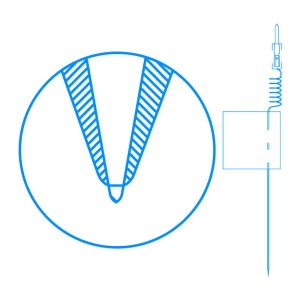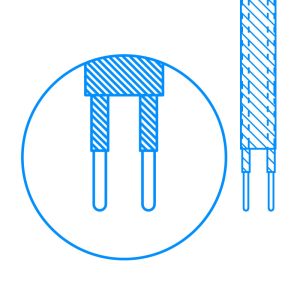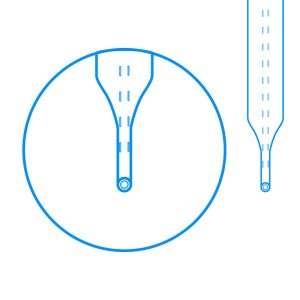For Research Only – Not For Human Use
These concentric bipolar microelectrodes are designed for acute research and can be used to stimulate multiple cells.
Detailed specifications and technical information can be found under the Technical Documents tab.
Sold in packages of 3.
These microelectrodes have a Platinum-Iridium inner pole and a Stainless Steel outer pole.
| SKU |
Tip |
Diameter Outer/Inner Pole |
Length |
| 30200 |
Rounded |
125/25 µm |
75mm |
| 30201 |
Extended |
125/25 µm |
50mm |
| 30202 |
Cone |
125/25 µm |
50mm |
| 30203 |
Cone |
125/12.5 µm |
50mm |
| 30204 |
Extended |
125/12.5 µm |
50mm |
| 30205 |
Rounded |
200/25 µm |
75mm |
| 30077* |
Extended |
|
Detachable 65mm tubing |
| 30213 |
Cone |
125/25 µm |
75mm |
| 30214 |
Extended |
125/25 µm |
75mm |
| 30215 |
Cone |
200/50 µm |
75mm |
*The 30077 Mass General Concentric Bipolar Microelectrode has a built in ground cannula
Refrence the table below if you are looking for a common custom Concentric Bipolar microelectrode number
| Custom Microelectrode Code |
Closest/Matching Standard Number |
Differences |
| CBARC75 |
30200 |
Exact Match |
| CBBRC75 |
30205 |
Exact Match (contact FHC to order) |
| CBAEC75 |
30201 |
Same base product, but the standard microelectrode is 25mm shorter (contact FHC to order) |
| CBBRF50 |
30205 |
Inner pole diameter is 50 microns, standard IP is 25 microns. Length is 50mm, standard length is 75mm (contact FHC to order) |
| CBBRF75 |
30205 |
Inner pole diameter is 50 microns, standard IP is 25 microns (contact FHC to order) |
The Mass General CB Special Specifications
Download
Cleaning and Sterilization of Research Microelectrodes
Download
Rajalingham R, Musallam S (2017) Characterization of neurons in the primate medial intraparietal area reveals a joint representation of intended reach direction and amplitude. PLoS ONE 12(8): e0182519.
Go To Publication
Li Feng, Joshua E. Motelow, Chanthia Ma, William Biche, Cian McCafferty, Nicholas Smith, Mengran Liu, Qiong Zhan, Ruonan Jia, Bo Xiao, Alvaro Duque and Hal Blumenfeld. Seizures and Sleep in the Thalamus: Focal Limbic Seizures Show Divergent Activity Patterns in Different Thalamic Nuclei. Journal of Neuroscience 22 November 2017, 37 (47) 11441-11454
Go To Publication
Hsu, L., Zelenin, P. V., Orlovsky, G. N. and Deliagina, T. G. (2017), Supraspinal control of spinal reflex responses to body bending during different behaviours in lampreys. J Physiol, 595: 883-900.
Go To Publication
Yong-Jun Liu; Maziar Hashemi-Nezhad; David C. Lyon Differences in orientation tuning between pinwheel and domain neurons in primary visual cortex depend on contrast and size. Neurophotonics, 4(3), 031209 (2017).
Go To Publication
DeWind NK, Peng J, Luo A, Brannon EM, Platt ML (2017) Pharmacological inactivation does not support a unique causal role for intraparietal sulcus in the discrimination of visual number. PLoS ONE 12(12): e0188820.
Go To Publication
Masri, S., Zhang, L. S., Luo, H., Pace, E., Zhang, J., & Bao, S. (2018). Blast Exposure Disrupts the Tonotopic Frequency Map in the Primary Auditory Cortex. Neuroscience, 379, 428–434.
Go To Publication





